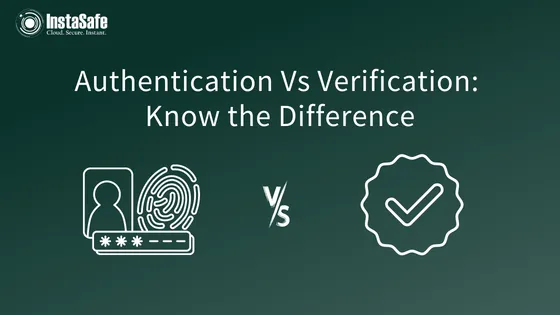Authentication Vs Verification: Know the Difference

Whether it's setting up a bank account, engaging in online transactions, or creating a new social media account, authentication and verification are essential in our daily lives.
Although these two terms (verification vs authentication) share similar purposes, upon closer inspection, they have distinct differences that we will delve into.
Biometrics and other types of security rely on authentication and verification to safeguard against fraud and other cybercrimes. However, due to data breaches and identity theft, establishing trust online has become increasingly challenging for both individuals and organisations.
Nonetheless, these same factors make it all the more necessary to prioritise online security measures. We must first discuss the identification process to understand the difference between verification and authentication.
What is Identification?
Identification is the process of recognising someone's identity. For instance, when purchasing a pair of shoes online, users must input their credit card number and billing address.
However, relying solely on the identification process can be risky, as individuals with access to the cardholder's information can easily gain acceptance using fraudulent means.
A company that relies solely on identification acknowledges that they have no reason to doubt the authenticity of the information provided by the individual, even though they haven't independently verified it.
It's akin to asking, "Who are you?" and accepting the response without any further investigation.
What is Verification?
Verification goes beyond just inquiring, "Who are you?" and poses the question, "Are you really who you claim to be?"
Verification enquires about an individual's identity and also verifies if the information provided is accurate, thereby instilling a significant level of confidence in the validation process.
Simply put, verification confirms an individual's identity as per their claim. This process is generally carried out by requesting specific information such as their phone number, date of birth, or official ID documents, which are then validated against a reliable source to ensure their authenticity.
What is Authentication?
Authentication is the process of verifying that the person attempting to access an account is indeed the same individual whose digital identity was previously verified. It ensures that only authorised individuals have access to the account tied to the verified identity, thereby enhancing its security.
Most systems employ three types of authenticators:
- Something the user knows (such as a password or security question),
- Something the user has (like an ID badge or cryptographic key), and
- Something the user is (such as facial recognition or biometric data).
Let's take an example of biometric authentication vs verification. Biometric authentication refers to the process of comparing a person's live physical characteristics, such as their face, fingerprint or iris, with biometric data that has been previously stored.
In contrast, biometric verification involves confirming a user's identity through official identification documents, such as a passport or driver's licence.
Now, due to the increasing occurrence of data breaches, the first two types of authentication methods - based on what you know or have - can no longer be deemed secure or reliable. The most reliable authentication method involves proving that you are who you claim to be by employing Multi-factor Authentication techniques that require the use of more than one type of authenticator.
Also Read: Authentication vs Authorisation
Understanding the Difference Between Authentication and Verification
Verification and authentication are two sides of the same coin.
Verification is the process of validating the information provided by the customer to confirm its authenticity. On the other hand, authentication is the process of determining whether the person attempting to access an account is authorised to do so.
Verification involves the submission of identification documents such as a driver's license, ID, or passport to prove that the individual is genuine and has no malicious intentions.
In contrast, authentication involves a deeper level of scrutiny than verification. Rather than simply confirming the user's identity, authentication requires them to provide unique and secret information, such as a PIN or password, known only to the user and the system.
To understand identity verification vs authentication, we must know verification is a one-time process aimed at verifying the authenticity of the individual. However, authentication is an ongoing process aimed at continuously validating that the person accessing the account is indeed who they claim to be.
Final Words
As more people conduct their daily activities online, it is increasingly important to establish trust by accurately identifying, verifying and authenticating users with as little difficulty as possible. This applies to everything from routine shopping to more significant transactions.
Therefore, if you are interested in implementing user authentication, check out InstaSafe Technologies for your organisation.
Our adaptive Multi-Factor Authentication is flexible and easily configurable, providing smart and secure access for successful user verification and secure remote access with SSO and MFA.
To learn more, book a free demo today!
Key Products
Multi Factor Authentication | Identity And Access Management | ZTNA | Zero Trust Application Access | Secure Enterprise Browser
Key Features
Single Sign On | Endpoint Security | Device Binding | Domain Joining | Always On VPN | Contextual Access | Clientless Remote Access | Device Posture Check
Key Solutions
VPN Alternatives | DevOps Security | Cloud Application Security | Secure Remote Access | VoIP Security
